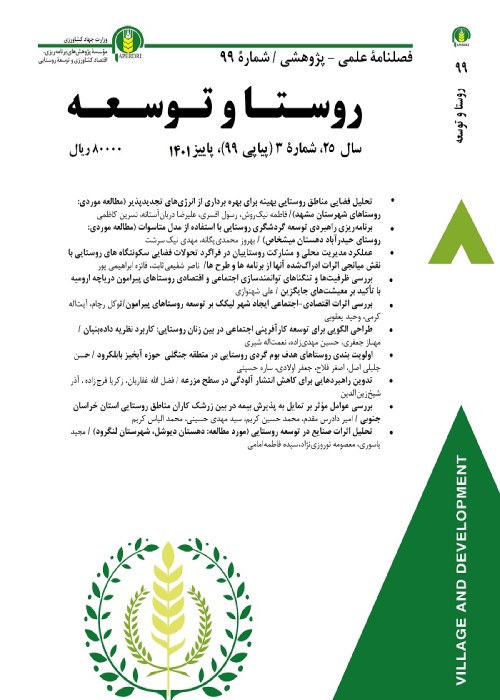Analysis of the Natural Capital Status of Sustainable Rural Livelihood through System Thinking Approach:(Case Study: Eastern Villages of Qarabagh City, Afghanistan)
The concept of Natural capital has emerged as a crucial element in the economic and social surveys of modern societies. It plays a pivotal role in promoting sustainable rural livelihoods and development across all dimensions. The recognition of natural capital as a valuable asset has gained significant attention in recent years, as it provides a framework for understanding the economic value of natural resources and the services they provide. This concept has become increasingly relevant in the context of sustainable development, as it highlights the importance of preserving and managing natural resources for the benefit of present and future generations. Therefore, policymakers and stakeholders must recognize the significance of natural capital and incorporate it into their decision-making processes to ensure sustainable development. Livelihood capital, which comprises environmental, social, physical, human, and financial capital, is a fundamental component of people's livelihoods, particularly those who are impoverished. These capitals are the cornerstone of sustainable livelihoods and are essential factors for local poor communities. Understanding the livelihood status of households and their access to livelihood funds is crucial for advancing development goals in rural areas, particularly in developing countries. It is one of the most significant and influential platforms for achieving this objective. Upon reviewing previous literature, it is evident that the application of a system approach in analyzing sustainable rural livelihoods has not received adequate attention. Given that the discussion of sustainable rural livelihoods involves different capitals, each comprising interrelated variables, neglecting the interrelationships between these variables may not be effective in addressing the issues at hand. Furthermore, disregarding feedback loops and dynamic complexity in a system can lead to political resistance. Therefore, this study aims to investigate the role of natural capital in sustainable rural development using a systemic approach.
System dynamics is a method that has been used to study and investigate the relationships between separate systems that are at the same time closely connected and enjoy dynamics in behavior. Dynamic simulation is useful for modeling the behavior of a system and observing its reaction to various changes over time. One of the most important features of the dynamic system is considering an endogenous structure of the studied system to show the reaction of different elements of the system on each other and the feedback effects between them. This approach enables us to gain a deeper understanding of the system's behavior and identify the factors that influence it. This study aims to conduct an analysis and provide an explanation of the natural capital of sustainable rural livelihoods using a systems thinking approach. The first step involved identifying the key variables of the system through a questionnaire and expert interviews in the study area. Subsequently, a new questionnaire was designed, and 120 residents in Qarabagh city, Ghazni province in Afghanistan were interviewed using Cochran's formula and targeted sampling via the snowball technique. The assessment of the region's situation was conducted in terms of key environmental asset variables.
The study suggests that the availability of water and forest per capita is likely to decrease due to factors such as population growth, deforestation for agriculture, fuel and charcoal extraction, livestock grazing, and fire. Mismanagement of natural areas has led to their destruction and reduction. Efforts to stop and reduce this process have been insufficient and unscientific. Deforestation has irreversible consequences and will significantly impact the natural ecosystem and sustainable rural livelihoods in the region. Afghanistan is facing severe water problems due to frequent droughts and excessive extraction of surface and underground water. The country's water situation has reached a critical level, and it is essential to invest in different parts of the water area to protect the surface and underground water sources. The reduction of desired variables is related to the increase in population and the need for more water and food resources. The development of the agricultural sub-sector can lead to over-harvesting of water resources and destruction of the forest. Therefore, natural resource management policies should be given more attention to ensure sustainable rural livelihoods. Water demand management is a practical and quick step in controlling water resources. Demand-oriented management policies, such as setting a reasonable tariff for water and improving irrigation technology, should be put on the agenda. To preserve and protect forest resources, caretakers should be made aware of the issue and executive bodies should stay more coordinated. Other solutions include developing fodder cultivation for livestock in low-yielding rainfed areas, expanding research, organizing environmental organizations, implementing successful forest management plans, attracting private sector investment, continuing the implementation of forestry projects, and planting productive forest trees in the empty parts of the forest by the residents. Identifying the state of environmental (natural) capital helps planners design rural development strategies and sustainable livelihoods with the capacities of the region.
Natural capital is an essential predictive component that provides the basis for rural development. Therefore, effective measures should be taken to strengthen environmental capital, and attention should be paid to it in formal and informal curricula. It seems that the current policies in the study area in the field of environmental asset management are not in line with achieving the development of sustainable rural livelihood. The government should invest in the development of irrigation technology to support the plans that seek to save available water while helping the development of the agricultural.
- حق عضویت دریافتی صرف حمایت از نشریات عضو و نگهداری، تکمیل و توسعه مگیران میشود.
- پرداخت حق اشتراک و دانلود مقالات اجازه بازنشر آن در سایر رسانههای چاپی و دیجیتال را به کاربر نمیدهد.


